Ancient Chinese Architecture
Pagodas – Chinese Culture
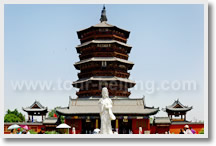 The pagod originated from India, and was introduced to China along with Buddhism in the Han Dynasty. The pagoda, a transliteration from Indic Sanskrit, originally meant the grave where the remain of Indian monks of high rank were kept after they passed away.
The pagod originated from India, and was introduced to China along with Buddhism in the Han Dynasty. The pagoda, a transliteration from Indic Sanskrit, originally meant the grave where the remain of Indian monks of high rank were kept after they passed away.The ancient pagoda we see today are a combination of both Indian and Chinese architecutural art, and they come in various shapes and forms. As far as appearance is concerned, there are pagodas built with wood, bricks, rocks, iron, bronze, glazed tiles or even gold, silver or pearls. Normally, the number of stories varies from five to 13, but it is always an odd number..
The Wooden Pagoda in Yingxian county, Shanxi province, was built 1,000 years ago. It has 9 stories, and is up to 70 m high. It is the oldest and highest still exsiting timber pagoda building in the world. Through seven earthquakes, it has remained absolutely still.
Bridges – Chinese Culture
The bridge is one of the most important components of ancient Chinese architecture. For thousands of yars, the Chinese have built tens of thousands of ingeniously designed and magnificent bridges.
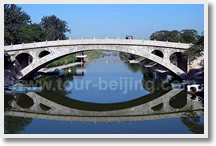
Crossing over mountains, spanning rivers, they have facilitated transportation, beautified landscapes and have become one of the marks of ancient Chinese civilization.
Baqiao Bridge in Xi’an, built in the Han Dynasty, is the earliest bridge with stone piers in China. It is 386 m long with 64 arches. It served as the key passage linking the vast areas to the east of the capital city Chang’an.It is by far the oldest in age, longest in span, and most grandiose in scale, multi-span stone arch bridge known today.
Zhaozhou bridge in Zhaoxian County of Hebei Province dates back 1,400 years ago to he Sui Dynasty. It is the fist single arch stone bridge in the world.
There are many unique features about this bridge. Some 50 m long, it has mild slopes that makt it easy for horse-pulled carts and pedestrians to cross. On its shoulders there are four arch-shaped holes, which not only save building materials and lessen the weight of the bridge but also help ease the flow of water in time of flood.
Lugou Bridge over the Yongding River in the suburb of Beijing has a history of more than 900 years. It is 260m long with more than 200 stone columns on both sides. The most intereting scene is that each column is crowded with a carved lion which has its individual posture. Visitors would usually count the stone lions to know the exacet number.
There are many other ancient bridges in China. The famous ones include Ping’an Bridge in Jinjiang and Luoyang Bridge in Quanzhou of Fujian Province, Jiuqu Bridge in the West Lake of Hangzhou, Baodai Bridge in Suzhou and the Yudai Bridge in the Summer Palace of Beijing.
The Imperial Palace – Chinese Culture
The imperial palace was the residence of the emperor and his family. In order to show the supremacy of the imperial family and their authority to rule the country, palace architects in ancient China unanimously pursued grandeur and magnificence in their design and construction.
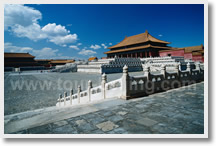
The imperial palace complex in ancient China was usually divided into two parts. The front part was for the emperor to meet his ministers and talk about state affairs, while the rear was used for residential purposes only.
The main buildings were all built along a central south-north axis, while auxiliary buildings stood symmetrically on each side. Row upon row of courtyards and lines after lines of palatial halls demonstrated regal uniformity, solemnity and dignity.
Most of the palace buildings adopted large sloping roofs. The roof was not only decorative, but also protective, as the overhang with upturned corners ensured that rain water would flow along the roof grooves and fall into places far from the wooden structures of the building.
Zoomorphic ornaments on the upturned roof corners were intended to add a sense of mystery to the place, and moreover, served a practical purpose in fastening the roof and keeping water out. The roofs were made of glazed golden tiles. Since this color was a symbol, it could only be used by imperial family.
Wooden buildings were a basic feature of ancient Chinese architecture. Beams, pillars, windows, gates were all made of wood and were painted red symbolizing happiness and riches and honor. Pictures of dragons, phoenixes, clouds, flowers and grass were sometimes painted on the surface, which not only made the buildings look more magnificent but had the practical purpose of protecting the wood from damp and infestation.
the Forbidden City, in Beijing, is the largest wooden structural complex in the world today and had been used by 24 emperors of both the Ming (1368-1644) and Qing (1644-1911).
The Hall of Great Harmony in the Palace Museum in Beijing is the largest wooden structure in China today. It was seated upon 3 layers of white marble stone foundations, surrounded by stone columns and stone steps inscribed with patterns of dragons and flowers, all of which have exquisitely carved.
At the back of the Hall is the steps and pathway, paved with monolithic stones. All the stones were sculpted with waves, clouds, and giant flying dragons, symbolizing the imperial magnificence.
The Palace Museum is palace of luxury and extravagance, moreover, it is a museum of architecture arts.
Temples – Chinese Culture
China is a country with diversified religion. Apart from the indigenous Taoism,
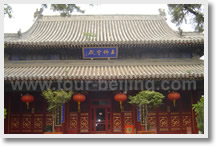 there are Buddhism, Islam and Christianity which were introduced into China from foreign lands.
there are Buddhism, Islam and Christianity which were introduced into China from foreign lands.
Although Buddhism was first introduced into China from ancient India, Buddhist buildings have obviously been localized since then. Most of Buddhist temples are built in remote mountainous areas far away from city centers.
Most of the ancient temples were designed in a way that the entrance gate would face the central main road. Inside the gate, to the left and right were the Bell and DRUM Towers. Confronted was the Hall of God, followed by the Hall of Great Wisdom.
Further back was the Tower of Scriptures. Other structures such as monk’s residences, kitchens and dining rooms, were located at the sides along the center passage. The Chinese ancient temple was a vivid imitation of the imperial palace building, in terms of its layout, the structure of the main altar room, and the construction of the roof structure.
While inheriting the palace building’s grandeur and magnificence, the Chinese Buddhist temple structure created its own unique style.
This is especially so with the Four Buddhist Holy Mountains, namely, Mt. Wutai, Mt.Ermei, Mt,Jiuhua and Mt. Putuo, where renowned temple buildings over the past dynasties located, such as Foguang Temple and Nanchan Temple in Wutai Mountains.
Buddhism has been practiced extensively in China as numerous temples have been considered throughout the country. These monastery establishments not only symbolize Buddhist culture, record he ancient social and cultural development, but also witness the rise and fall of Buddhism. They are of great historical and artistic value.
Classical Garden – Chinese Culture
Classical gardens throughout China, with their beautiful scenery and unique structures, attract many tourists.
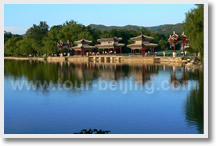
The most prominent feature of classical Chinese gardens is the emphasis on the harmony between nature and human. Ancient garden architects successfully integrated man-made scenes into the natural landscape, creating the impression of traveling in a picture of grotesque peaks, exotic rocks, flowing currents, tranquil lakes, fragrant flowers and rare plants.
Chinese classical garden are often full of surprise in terms of scenes, variable in composition and complicated in design. Serpentine walkways, for instance, lead to places of tranquility.
Much attention is paid to the creation of varied scenery; with each step, one can see a different scene. Buildings of different forms and different architectural styles are well integrated with the garden scenery. Flowers, plants and trees are elaborately cultivated and planned with a definite eye on their heights and blooming seasons.
Another feature of classical Chinese garden is that decorative art is ingeniously meerged with the garden scenery. On buildings there are horizontal boards carved with calligraphy, antithetical couplets, and painted beams with carvings.
Classical Chinese garden can be roughly divided into two categories, namely, the royal gardens in the north and private gardens in the north and private gardens in the south.
Royal gardens tend to make use of natural elements in creating clusters of stylish architectural structures in imitation of the best in the county.
With golden glazed titles, vermilion colonnades, white marble balustrades, refined ornamented beams, they are filled with a sense of magnificence and grandeur.
Questions & Answers:



